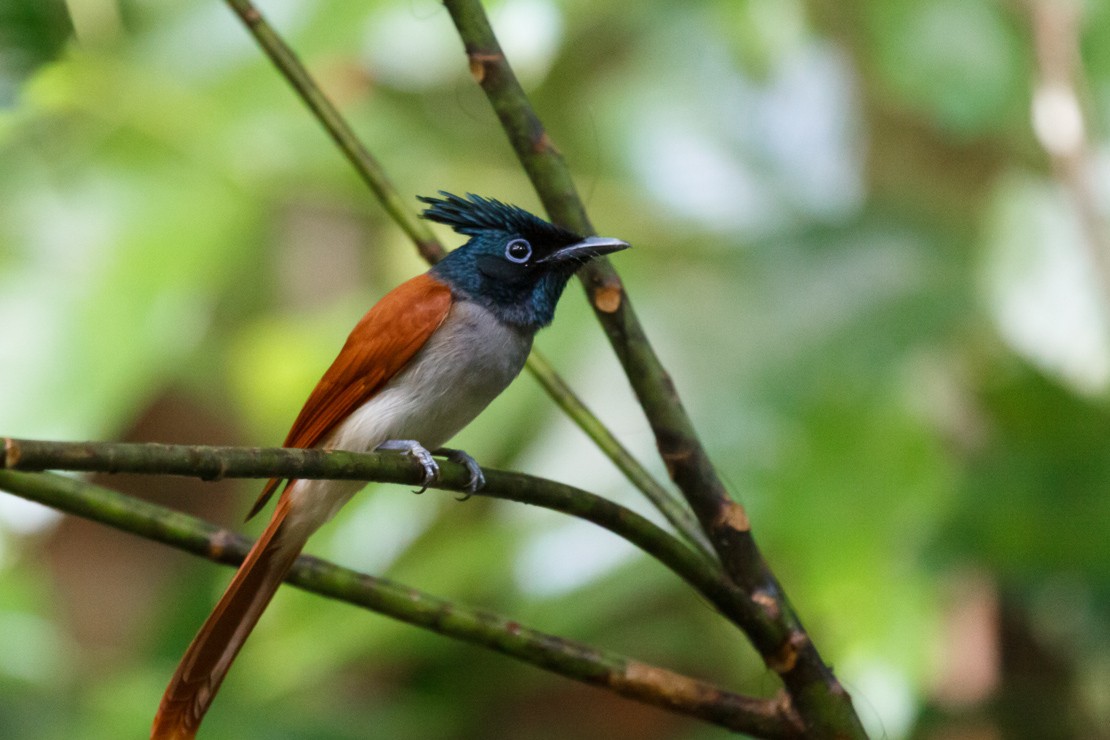Indian Paradise Flycatcher
A species of Paradise Flycatchers Scientific name : Terpsiphone paradisi Genus : Paradise Flycatchers
Indian Paradise Flycatcher, A species of Paradise Flycatchers
Botanical name: Terpsiphone paradisi
Genus: Paradise Flycatchers
Content
Description General Info
 Photo By Thimindu Goonatillake , used under CC-BY-SA-2.0 /Cropped and compressed from original
Photo By Thimindu Goonatillake , used under CC-BY-SA-2.0 /Cropped and compressed from original Description
Adult Indian paradise flycatchers are 19–22 cm (7.5–8.7 in) long. Their heads are glossy black with a black crown and crest, their black bill round and sturdy, their eyes black. Female are rufous on the back with a greyish throat and underparts. Their wings are 86–92 mm (3.4–3.6 in) long. Young males look very much like females but have a black throat and blue-ringed eyes. As adults they develop up to 24 cm (9.4 in) long tail feathers with two central tail feathers growing up to 30 cm (12 in) long drooping streamers. Young males are rufous and have short tails. They acquire long tails in their second or third year. Adult males are either predominantly bright rufous above or predominantly white. Some specimens show some degree of intermediacy between rufous and white. Long-tailed rufous birds are generally devoid of shaft streaks on the wing and tail feathers, while in white birds the shaft streaks, and sometimes the edges of the wing and tail feathers are black. In the early 1960s, 680 long-tailed males were examined that are contained in collections of the British Museum of Natural History, Chicago Natural History Museum, Peabody Museum, Carnegie Museum, American Museum of Natural History, United States National Museum and Royal Ontario Museum. The specimens came from almost the entire range of the species, though some areas were poorly represented. The relative frequency of the rufous and white plumage types varies geographically. Rufous birds are rare in the extreme southeastern part of the species' range. Throughout the Indian area and, to a lesser extent, in China, asymmetrically patterned intermediates occur. Intermediates are rare or absent throughout the rest of the range of the species. In general, long-tailed males are predominantly rufous with some white in wings and tail — collected in Turkestan, Kashmir, northern India, Punjab, Maharashtra, Sikkim and in Sri Lanka; predominantly rufous with some white in wings — collected in Iran, Afghanistan, Baluchistan, Punjab, Kashmir, northern and central India, Rajasthan, Maharashtra, Bihar, Nepal; predominantly rufous with some white in tail — collected in Punjab, northern and central India, Kolkata, Sri Lanka and in the Upper Yangtze Valley in China; predominantly white with some rufous in tail and wings — collected in Kashmir, Maharashtra, Sichuan and North China; predominantly white with some rufous in tail — collected in Maharashtra and Fuzhou, China; predominantly white with back partly rufous — collected in Punjab and Chennai; moulting from rufous into white plumage — collected in North Bihar. Possible interpretations of this phenomenon are : males may be polymorphic for rufous and white plumage colour; rufous birds may be sub-adults; and there may even be two sympatric species distinguishable only in the male. 
Size
20 cm
Nest Placement
Tree
Feeding Habits
Indian Paradise Flycatcher predominantly consumes small winged insects, occasionally hunting larger prey like mantises. It forages alone or in pairs, often from an upright perch, employing aerial hawking and occasionally gleaning from foliage. Indian Paradise Flycatcher might also join mixed-species flocks, feeding mainly within 2 meters of the ground.
Habitat
Indian Paradise Flycatcher generally inhabits thick forests and well-wooded regions across broad geographical stretches from Central Asia to Southeastern China and the Himalayas. It is also found in groves, plantations, gardens, and shrublands, especially during the winter season. Habitats range from sea level to mountainous areas, with elevation preferences varying by region; in certain parts of the Himalayas, indian Paradise Flycatcher is found between 1200 to 3100 meters.
Dite type
Insectivorous
General Info
Feeding Habits
Bird food type
Behavior
The Indian paradise flycatcher is a noisy bird uttering sharp skreek calls. It sits very upright whilst perched prominently, like a shrike. It is insectivorous and hunts in flight in the understorey. In the afternoons, it dives from perches to bathe in small pools of water. Its breeding season lasts from May to July. Being socially monogamous both male and female take part in nest-building, incubation, brooding and feeding of the young. The incubation period lasts 14 to 16 days and the nestling period 9 to 12 days. Three or four eggs are laid in a neat cup nest made with twigs and spider webs on the end of a low branch. The nest is sometimes built in the vicinity of a breeding pair of drongos, which keep predators away. Chicks hatch in about 21 to 23 days. A case of interspecific feeding has been noted with paradise flycatcher chicks fed by Oriental white-eyes. 
Distribution Area
The Indian paradise flycatcher is a migratory bird and spends the winter season in tropical Asia. In southern India and Sri Lanka, both locally breeding populations and visiting migrants occur in winter. Indian paradise flycatchers inhabit thick forests and well-wooded habitats from Central Asia to south-eastern China, Nepal, all over India and Sri Lanka to Myanmar. 
Species Status
Not globally threatened.
Scientific Classification
Phylum
Chordates Class
Birds Order
Perching birds Family
Monarchs Genus
Paradise Flycatchers Species
Indian Paradise Flycatcher